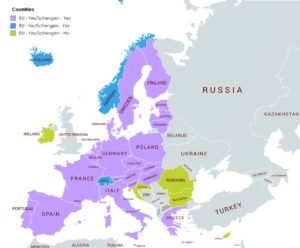EU Begins New Biometric Entry-Exit System
|
General Studies Paper II: Important International Institutions, Effect of Policies & Politics of Countries on India’s Interests |
Why in News?
The European Union has officially launched its new Biometric Entry/Exit System (EES), bringing a major shift to manage borders across member nations to ensure smoother and more secure entry of all non-EU travellers.
What is The New Biometric Entry-Exit System (EES)?
- About: The Entry/Exit System (EES) is a new electronic system the European Union will use to register non-EU nationals when they enter or leave the Schengen Area. It replaces the old method of stamping passports manually. The EES is operated by the EU’s IT agency eu-LISA.
- Implementation: The rollout will happen in phases between 12 October 2025 and 10 April 2026 by the EU under its Smart Borders Initiative. At first, each participating country must activate EES at at least one external border. Over the months, more border points will join until all external crossings are under EES. During the transition, traditional passport stamping continues until full activation. Some countries may offer facilitation programs to ease border crossings for frequent travelers.
- Aims: The EES has several main objectives:
-
-
- Modernize border control: Move from manual procedures to a digital, automated system to speed up checks.
- Improve security: Better identify unauthorized or irregular movements, reduce identity fraud, and detect those who overstay their legal visit period.
- Track compliance: Automatically compute how long non-EU nationals have stayed and alert authorities if they exceed the 90/180 rule.
- Optimize resources: Allow border guards and member states to handle higher travel volumes without proportionally increasing staffing.
-
- Regulation: The system is grounded in EU law and regulations that define its scope, data protection safeguards, and operational rules. Regulation (EU) 2017/2226 and Regulation (EU) 2017/2225 of the European Parliament ensures respect for fundamental rights including privacy and data protection.
|
Schengen Area
|
Key Features of the Entry/Exit System (EES)
- Biometric Registration: EES collects facial images of travellers. It also captures fingerprints (two prints per person). It links biometric data with the traveller’s identity. On the first entry, the system registers these biometrics. In subsequent entries, biometrics help verify identity quickly.
-
- Travel Document: EES records the name, date of birth, nationality and passport number of each traveller. It logs the issuing country and expiry date of the travel document. It also notes entry and exit dates and border crossing points.
- Automated Entry-Exit Logging: Each time a traveller enters or leaves, EES logs that motion. It ensures every crossing is recorded digitally. It will replace passport stamps at external borders. There is no fee for using the EES.
- Stay Compliance Monitoring: EES automatically computes how many days a non-EU person has stayed. It enforces the 90 days in any 180-day rule for short stays. If a person overstays, the system can flag that automatically. It helps authorities detect violations early.
- Exemptions: EU nationals do not fall under EES rules. Long-term residents and holders of residence permits are usually exempt. Children under a certain age (often under 12) may be exempt from fingerprints in some cases.
- Integration with EU Systems: EES is operated by eu-LISA, the EU’s IT agency for large-scale systems. It connects with other EU databases like visa systems and security databases. It helps border guards check for fraud, watchlists, or security concerns.
- Automated Border Control: Many borders will use self-service kiosks or automated gates (ABC gates). Travellers may scan their passport, face and fingerprints themselves. The system speeds up processing.
- Format Across Countries: EES applies in 29 Schengen and associated countries. These include many EU states and some non-EU ones (like Norway, Switzerland). All external border crossings in these states must adopt it.
- One-Time Registration: A traveller registers once per valid travel document. After registration, subsequent entries in the validity period use stored data. If the passport changes or is renewed, new registration is needed.
- Locations: EES checks will take place at airports, seaports, train stations, and road border crossings. In the UK, travellers departing through the Port of Dover, Eurotunnel in Folkestone, or Eurostar at London St Pancras will undergo mandatory EES registration.
How the Entry/Exit System (EES) Will Work?
- When travellers enter the Schengen Area for the first time under EES from 12 October 2025, they have to provide their personal information. Passport control officers will record full name, date of birth, nationality, and passport details. This information will create a digital record for each traveller.
- After this, officials will take a photograph of the traveller’s face and scan two fingerprints. This biometric data will link to the traveller’s digital record. The system will use these biometrics to verify identity on every subsequent entry or exit.
- Travellers will have the option to register their information in advance. They can use self-service equipment at participating border points. Alternatively, they can submit data via a mobile application if the country of arrival or departure provides one.
- For travellers who have crossed EES-enabled borders before, their photo and fingerprints will already exist in the system. Passport officers will scan these biometrics to confirm identity. This step will be quicker than the initial registration.
- On every subsequent entry or exit, border officers will scan fingerprints and take a facial photograph to verify the traveller. The system will compare these biometrics with the previously stored record. Verification will ensure accurate identification and reduce manual processing time.
- Since countries will implement EES gradually, some travellers may still receive passport stamps during the transition. Passport stamping will continue until full system deployment is complete at that location.
- Once travellers are registered during departure from the UK, they will not need to repeat the process on arrival in the Schengen Area.
Impact of the Entry/Exit System (EES)
- Border Security: The EES will strengthen Schengen border security by recording both personal and biometric data of all non-EU travellers. Now authorities will easily identify individuals who overstay or attempt to enter illegally.
- Faster Border Processing: With digital records and automated biometric verification, travellers will spend less time at checkpoints. Frequent travellers will have even quicker processing since their data will already exist in the system.
- Better Resource Management: Border authorities will spend less time on manual passport checks. Digital monitoring will allow smaller teams to manage higher volumes of travellers. This will lower operational costs and make border management more efficient.
- Preventing Illegal Activities: EES will link with other EU databases and watchlists. This integration will help identify persons flagged for security or criminal concerns. It will improve cross-border coordination and support law enforcement in preventing illegal activities.
Way Forward
- The Entry/Exit System (EES) is the first step towards the European Travel Information and Authorisation System (ETIAS). ETIAS is expected to start in late 2026. It will also require all non-Schengen citizens to obtain travel authorization before entering the Schengen Area.
- Since April 2025, European visitors to the UK must obtain an electronic travel permit before arrival. This is similar to ETIAS and reflects a broader trend in Europe for pre-authorisation of travellers. Such systems will make travel safer while simplifying entry processes for compliant travellers.
- In future, EES data will support ETIAS by providing a verified record of previous entries and exits. Authorities will be able to cross-check biometric and travel information easily.
|
Also Read: India-EU Trade Relations |











